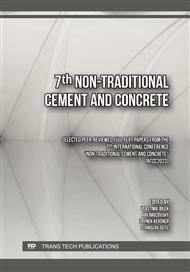[1]
"2022 Global Status Report for Buildings and Construction | UNEP - UN Environment Programme." https://www.unep.org/resources/publication/2022-global-status-report-buildings-and-construction (accessed May 05, 2023)
Google Scholar
[2]
S. Chowdhury, S. Mohapatra, A. Gaur, G. Dwivedi, and A. Soni, Study of various properties of geopolymer concrete – A review, Mater Today Proc, 46 (2021) 5687–5695.
DOI: 10.1016/j.matpr.2020.09.835
Google Scholar
[3]
M. G. Plaza, S. Martínez, and F. Rubiera, CO2 Capture, Use, and Storage in the Cement Industry: State of the Art and Expectations, Energies 2020, 13(21) (2020) 5692.
DOI: 10.3390/en13215692
Google Scholar
[4]
C. Carreño-Gallardo et al., In the CO2 emission remediation by means of alternative geopolymers as substitutes for cements, J Environ Chem Eng, 6(4) (2018) 4878–4884.
DOI: 10.1016/j.jece.2018.07.033
Google Scholar
[5]
J. L. Provis, Alkali-activated materials, Cement and Concrete Research, 114 (2018) 40–48.
DOI: 10.1016/j.cemconres.2017.02.009
Google Scholar
[6]
Z. G. Ralli and S. J. Pantazopoulou, State of the art on geopolymer concrete, International Journal of Structural Integrity, 12(4) (2021) 511-533.
DOI: 10.1108/ijsi-05-2020-0050
Google Scholar
[7]
J. Davidovits, Geopolymer Chemistry and Applications, 5th ed. Saint-Quentin, France (2020).
Google Scholar
[8]
A. Alsalman, L. N. Assi, R. S. Kareem, K. Carter, and P. Ziehl, Energy and CO2 emission assessments of alkali-activated concrete and Ordinary Portland Cement concrete: A comparative analysis of different grades of concrete, Cleaner Environmental Systems, 3 (2021).
DOI: 10.1016/j.cesys.2021.100047
Google Scholar
[9]
T. T. Nguyen, C. I. Goodier, and S. A. Austin, Factors affecting the slump and strength development of geopolymer concrete, Constr Build Mater, 261 (2020).
DOI: 10.1016/j.conbuildmat.2020.119945
Google Scholar
[10]
A. Albidah, M. Alghannam, H. Abbas, T. Almusallam, and Y. Al-Salloum, Characteristics of metakaolin-based geopolymer concrete for different mix design parameters, Journal of Materials Research and Technology, 10 (2021) 84–98.
DOI: 10.1016/j.jmrt.2020.11.104
Google Scholar
[11]
J. de Brito, R. Kurda, and P. R. da Silva, Can We Truly Predict the Compressive Strength of Concrete without Knowing the Properties of Aggregates?, Applied Sciences, 8(7) (2018) 1095-1116.
DOI: 10.3390/app8071095
Google Scholar
[12]
J. Dils, G. De Schutter, and V. Boel, Influence of mixing procedure and mixer type on fresh and hardened properties of concrete: A review, Materials and Structures, 45(11) (2012) 1673–1683.
DOI: 10.1617/s11527-012-9864-8
Google Scholar
[13]
E. Gomaa, T. Han, M. ElGawady, J. Huang, and A. Kumar, Machine learning to predict properties of fresh and hardened alkali-activated concrete, Cement and Concrete Composites, 115 (2021) 103863.
DOI: 10.1016/j.cemconcomp.2020.103863
Google Scholar
[14]
P. Chindaprasirt, P. De Silva, and S. Hanjitsuwan, Effect of High-Speed Mixing on Properties of High Calcium Fly Ash Geopolymer Paste, Arab J Sci Eng, 39(8) (2014) 6001–6007.
DOI: 10.1007/s13369-014-1217-1
Google Scholar


